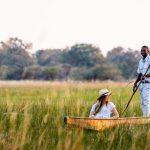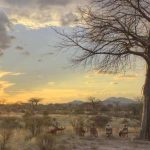We arrived at Msembe airstrip around mid-day – Pietro was there with a car to greet us. He had guests in camp, they were out on a game drive with Festo, the other guide. This camp has only two cars, which is fine for now, as there are only 6 tents, and the policy is that the guests go out with either Pietro or Festo, up to 6 to a car.
The cars are very comfortable, with bucket seats instead of benches as at the other three camps. We drove back to tent, stopping only to view a lion kill just outside the camp.
The camp is very attractive, being on a ridge above the Mwagusi, with cooling breezes. The Lounge and dining tents are spacious, and easily reached from the car park. We were taken to our tents – these are set on either side of the lodge tents, which is good as the view is not spoiled.
All tents are white, which is very pleasant as inside is light and airy. They are bigger than the other camps, with a special design, very attractive. The decoration and finishing is very tasteful, utilising natural materials, weavings, seeds and fibres, pots, and very nice wrought iron work stands for clothes etc. My tent was very well equipped, with two chests of drawers for clothes, bedside lights and standard lights – all EL is provided for these (from solar panels and a central inverter which you don’t hear). And also for sockets for charging machines. Bottled water was provided in the tents.
I would highly recommend a standing fan in each tent if possible. The tents are very hot, as there is no shade at all for them. Alternative would be to have a higher gap between the ceiling and the top of the tent.
The lounge and dining tents are much cooler, with some shade of trees, but also the gap between tent roof and the canvas top roof is quite wide, almost a metre.
At the tents, the gap seems to be only about 20 cms , and they are very warm in the middle of the day, though pleasant at night.
There are gauze sections on all sides, these can be unzipped to the floor on two sides, so according to where the breeze comes from the tents can be adapted to allow a breeze.
the bathrooms are separated from the bedroom only by a curtain, as at Impala – at Manze and Mdonya there is a zip between these sections, which is difficult to negotiate at night – because of the skylight showers.
The bathrooms have bucket showers, which I’m not sure I really liked – there was never hot water in the evening, though there would have been if I had asked. It did not come automatically then though, I think it was filled at lunchtime, when you don’t really need hot water. Also the water being from the big river, was not very clear.
This will change next season, when a new camp is being built nearby in a beautiful position on a rocky hill above the Mwagusi. It will have its own borehole.
There was a very good Maglite torch for use at night, and guides came to collect the guests for dinner as at the other camps.
Laundry is complimentary, as at Impala.
Early morning tea/coffee is available.
The food was very good, dinner under the stars – this is changed to different locations every night, for variety. There is also a nice campfire area. Dining is communal, Pietro makes a wonderful host, joined by Festo who is extremely personable and knowledgeable.
Re the menus, I would suggest that maybe a little more fresh produce might be used, as at Mdonya – Micol has two good sources of supply from Iringa and from the nearby village.
Kwihala is all about the guiding, which is always done by the managers themselves. The standard is so far above anything offered at other camps I’ve been to.
There are two game drives per day and cars return to camp for lunch. There is not much point in all day game drives here, as the camp is so nicely located in the best game area of Ruaha, and not too far from the Great Ruaha, and it is easy to return and relax in the tents during the heat of the day. If guests would like an all day drive however, the managers are flexible and arrange this, with picnic lunch.
Most morning game drives depart around 6.30 and a very nice “bonnet breakfast” was provided at a picturesque spot. This involved laying out the food and utensils on the bonnet of the car – no safari chairs and tables. People help themselves, it’s a little less “colonial” and people do enjoy it, and also to be able to stretch the legs a little is nice. Pietro picked a beautiful location by a granite kopje with lovely views.
A cool box with drinks and bottled water was provided in the car. Drinks are all complimentary.
Each time we arrived back at camp there were cold towels and juice waiting at the car park.
Before leaving next day we saw the new site for the replacement camp – Carlo will start to build this in Sept-Oct – he already has the building permit, as well as the permit to do walking from camp, which will also begin soon, done by Pietro or the other two managers, Steve and Mario, all of whom have licences, and are Fgasa level 3 trained.
The new site is amazing – a beautiful kopje above the Mwagusi, just west of the current camp. There will be a borehole (water is currently trucked in to the camp from the headquarters).
The reception, lounge and dining will be in the Kopje area, and will evolve as Carlo decides where to place things.
I would suggest the tents be placed 4 on either side of the lodge kopje, to avoid spoiling the view from the top, which is stunning.
Total tents is 8 or 9, I understand. Possibly 2-3 larger tents, with double/twin beds plus two sofas that can be made into extra beds, for families.
It is possible these could be more expensive, i.e. priced by the size of the tent, so honeymooners for example can have a bigger tent if they want it, and will pay for it.
Obviously more cars will be needed as the camp grows. Pietro is already training guides.
I understand the object is to be ready to open the new camp in June 2012.






